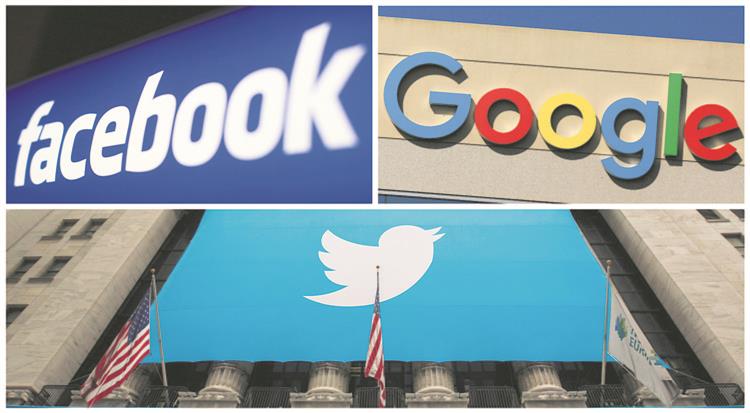
Ominous: The govt wants access to social media on the grounds of national security. Reuters
Luv Puri
Journalist and author
The Indian government’s current bid to enforce a new regulatory framework over social media companies has ignited the inevitable debate on the need to have a balance between regulating platforms to avoid their instrumentalisation by bad actors against the larger public good and allowing the public to benefit freely from the services offered by these companies while upholding the privacy of the users and other democratic rights.
India is one of the biggest markets for social media companies. In India, users of Twitter (about 186 million), Facebook (around 346 million), WhatsApp (about 390 million) and YouTube (approximately 425 million) are more than the population of some of the prominent countries where these social media companies are popular. In that case, what happens in India holds significance not just for the country, but the global operations of these social media giants as it creates an institutional precedent. In specific terms, as per the new digital rules under the existing Information Technology Act, the social media platforms will have to take down content flagged by the authorities within 36 hours and they have to set up domestic mechanisms to address complaints. The social media platforms have also been asked to inform the federal government about the status of compliance. The new rules in India take away the immunity for content posted by third-party users on these platforms if they don’t remove the post on being notified by the authorities.
The experience of the past decade, which has witnessed stupendous growth of social media companies and content in both developed as well as developing world, has reinforced the need for content moderation. The August 2017 event in Myanmar is a case in point. At least 6,700 Rohingya, including an estimated 730 children under the age of five, were killed in military violence, according to Medecins Sans Frontieres (Doctors Without Borders). A contributing factor seemed to be the hate speech against Rohingya facilitated by the social media platforms of the military. In 2018, a fact-finding mission set up by the Geneva-based UN Human Rights Council found that in Myanmar, “Facebook has been a useful instrument for those seeking to spread hate, in a context where for most users, Facebook is the Internet.” The 440-page report compiled after 15 months of examination, gave detailed examples of how the Rohingya community was demonised and recorded many cases “where individuals, usually human rights defenders or journalists, become the target of an online hate campaign that incites or threatens violence”.
In recent years, social media giants have been more sensitive to the public outcry over the misuse of these platforms. This is reflected in the establishment of internal mechanisms to flag hate speech and in some cases, taking down individual accounts for repeated misuse. Facebook has set up an independent board to evaluate its own decisions regarding action against bad actors. The change in the US political context is particularly important as these companies have their headquarters there. The ruling Democratic Party in the US is seen to be more sensitive to the argument that unfiltered social media messaging is exacerbating social and racial tensions and had reportedly called for revoking Section 230. The US laws had been used as a point of reference by these companies for global operations. For instance, Section 230 of the Communications Decency Act, 1996, of the US Congress grants them immunity from liabilities related to third-party-hosted content while allowing them flexibility to moderate content.
In addition to Twitter, as per India’s current digital rules, social media intermediaries such as WhatsApp with large user bases have been asked to enable tracing of the originator of information on their platform when asked by the authorities. WhatsApp has countered this and noted that tweaking end-to-end encryption would make their users vulnerable and will violate their privacy. This, it reportedly argues, will place “public and private players, placing journalists, civil rights activists and political activists at risk of retaliation”. In its defence, the government has argued that “India is not the only country seeking a regulatory mechanism to access limited data from end-to-end encrypted instant messaging platforms such as WhatsApp.”
National security is one of the reasons that had been cited for gaining access. Interestingly, the national security argument has not worked in the US when Apple was asked by the authorities to cooperate. In an infamous case in 2015, the Federal Bureau of Investigation (FBI) recovered an i-Phone used by assassin Syed Rizwan Farook, who along with his wife, had killed 14 people in San Bernardino county in California. Apple refused to help the FBI in unlocking Farook’s i-Phone as it considered the act as an infringement of its own privacy policy. Ultimately, the FBI was able to unlock the phone through a third party.
Within India, hate speech, particularly against the minorities, peddled through social media platforms, has led to physical attacks. Misogyny, caste slurs and online bullying through social media posts had been quite common. In the past, the companies were slow in reacting and they definitely need to be more aware of the granular nuances of the social context in which they are operating, rather than merely using a point of reference of the US. Reacting to the new rules, Twitter has reportedly accused the government of “dangerous overreach that is inconsistent with open, democratic principles” and alleged that it has been forced to ‘withhold’ (block tweets in India) portions of ‘legitimate free speech’ on its platform over fears around the safety of its employees and threats of financial penalties. The whole issue of executing new digital rules has become controversial because of the recent raids on Twitter and the reported Opposition charge that the recent raids on Twitter’s offices were illegal and politically driven to “give cover fire” to the ruling party that has been accused of sharing an allegedly fake ‘toolkit’.
To sum up, India’s own post-Independence journey illustrates that national security, respecting individual privacy, preventing social discord and checking misuse by the ruling party are all legitimate issues that should be on the table to address with rigour before formulating a comprehensive, objective and transparent regulatory framework for social media companies. In this exercise, the ruling party needs to involve the Opposition as well as varied domestic stakeholders.
Join Whatsapp Channel of The Tribune for latest updates.




























